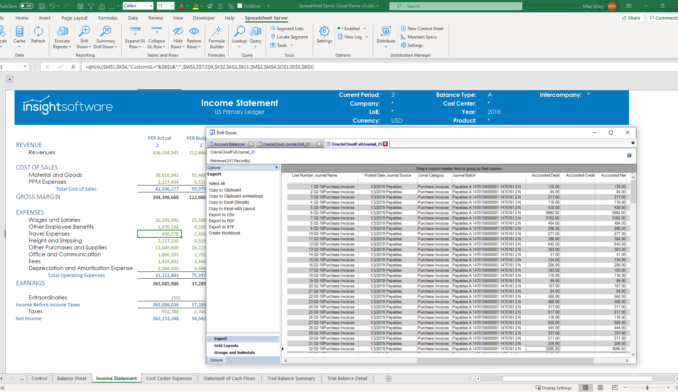CFO Guide to the CARES Act

In late March, Congress passed the Coronavirus Aid, Relief, and Economic Security Act (CARES Act), and President Trump signed it into law. It provides for approximately $2 trillion in economic aid in the form of loans, grants, and tax changes. Of that total, $349 billion is available to assist small businesses. Another $151 billion is earmarked for specific industries or is available to larger businesses, but it comes with some additional strings attached.
For most business leaders, this was welcome news. In the face of dramatic and immediate disruption, businesses around the world were concerned about plummeting revenue, supply chain uncertainties, and, above all, cash flow.
CFOs considering the CARES Act should focus primarily on these two questions: “How do we apply for and receive assistance?” and “What changes do we need to make to our accounting practices as a result of receiving economic assistance under the CARES Act?”
Assistance to Businesses
The Paycheck Protection Program (PPP) is a loan program with provisions for 100 percent loan forgiveness. It is intended to make it possible for small businesses to retain employees through this period of disruption. Administered by the Small Business Administration (SBA), PPP is an expansion of the traditional SBA 7(a) loan program.
PPP loans will be forgiven if all of a company’s employees are kept on the payroll for eight weeks, and the money is used for payroll, rent, mortgage interest, or utilities. Business owners can apply through any existing SBA lender (typically a bank with which they already normally do business).
If you already have a relationship with the SBA, you may also be eligible for an Express Bridge Loan of up to $25,000 and/or Temporary Debt Relief for an existing loan. The Temporary Debt Relief program does not require an application and is applied automatically by the SBA. It provides for up to six months of automatic payments by the SBA on existing 7(a) loans, 504 loans, and SBA microloans. If you made a payment after March 27, 2020, you have the option of either having the loan payment returned to you or having it applied to reduce your loan balance.
Not surprisingly, there has been a rush to take advantage of these programs, especially the Paycheck Protection Program. At the same time, lenders and government officials were scrambling to create new guidelines and manage the rollout in an orderly way.
As a result, the first round of PPP loans was fully subscribed almost immediately, and subsequent rounds have resulted in problems as millions of small businesses have tried to get in line for assistance. Things have gradually fallen into place, however, and millions of additional businesses have finally been able to secure PPP loans.
Tax Provisions
Although the PPP and other loan programs have garnered most of the attention, there are also some tax provisions in the CARES Act that are intended to provide additional relief.
The Employee Retention Credit provides for a 50 percent tax credit of up to $10,000 of wages paid or incurred between March 13, 2020 and the end of the year.
There is also a provision in the CARES Act that allows employers (and self-employed people) to defer certain payroll tax remittances to the federal government. The deferral applies only to the employer portion of Social Security taxes. Half of the required amount must be paid by December 31, 2021, and the other half by December 31, 2022.
The CARES Act re-opens the net operating loss (NOL) carryback provisions by providing a five-year carryback for losses incurred in 2018, 2019, or 2020. This allows firms to potentially carry back losses to reduce prior years’ tax liabilities. This could be especially beneficial in light of higher tax rates in those years. The law also suspended the 80 percent limit on NOLs and enables pass-through business owners to use NOLs to offset their non-business income.
Finally, the CARES Act relaxes some limitations on interest deductions and accelerates the recapture of Alternative Minimum Tax (AMT) credits.
Accounting Implications
There are several key areas that CFOs need to think about as a result of all this. First among these is the question of how to account for government assistance. GAAP does not provide any specific guidance as to how businesses should account for forgivable government loans, for example (although GAAP does provide such guidance for nonprofit entities). In the absence of specific guidance, accountants may look to similar GAAP guidance or to other standards-issuing bodies such as IFRS, which provides guidance for accounting for government grants in IAS-20.
Specifically, questions may arise as to the recognition of government assistance as income. Because grants typically come with strings attached, grant revenue should not be recognized unless or until an entity can establish that it has fulfilled all of the grant requirements. In addition, there may be questions as to how grant revenue should be presented. One option is to recognize it as revenue (for example, in an “other income” category). However, because many of these assistance programs are designed to cover specific expenses, some entities may wish to apply grant income as an offset to the corresponding expense lines.
Many have asked whether low-interest government loans should be accounted for using an imputed interest rate, with the difference vs. market rate being recognized as income. Experts from PwC, Deloitte, and others have confirmed that according to ASC 835-30, this is not necessary. Interest expense on PPP and other low-interest loan programs should be recognized at face value.
For financial institutions, the CARES Act temporarily delays the implementation date of FASB ASC Topic 326, which deals with Credit Losses on Financial Instruments (CECL) and suspends the requirements related to accounting for troubled debt restructuring (TDR) for some entities.
An Evolving Situation
The CARES Act has profound implications for employee hiring and retention, cash flow management, tax planning, revenue recognition, and much more. Above all, CFOs should keep in mind that the situation continues to evolve. As government agencies scramble to roll out loans and other assistance programs to millions of businesses, many questions have arisen. Without a doubt, additional guidance will be issued to clarify the questions that have arisen since the CARES Act was initially passed. CFOs are advised to keep a close eye on the situation and plan accordingly.
As CFOs maneuver through the turbulent financial environment in the wake of COVID-19, access to solid resources can help. Ensure business continuity during the COVID-19 crisis.







